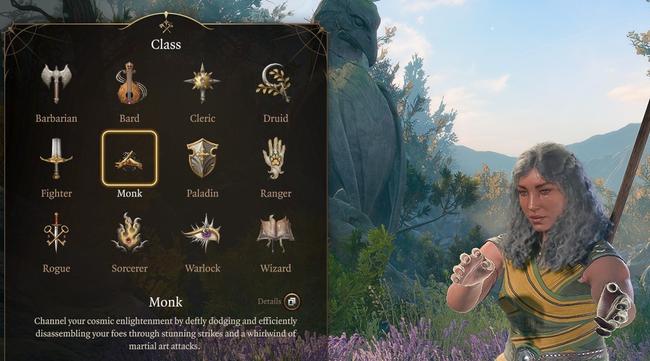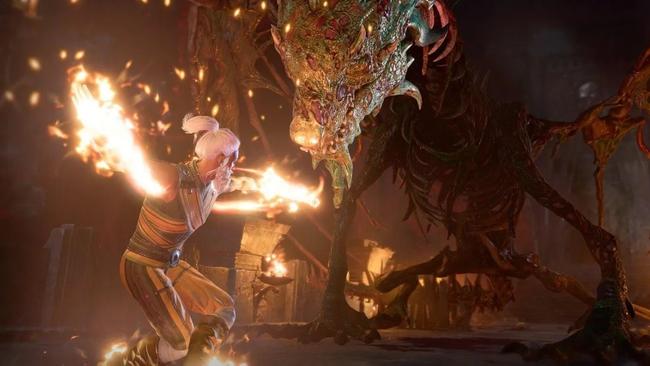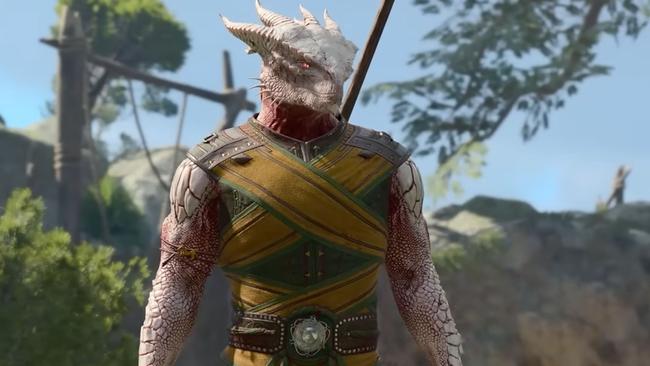
Baldur's Gate 3 Monk Class Guide - Martial Arts, Unarmored Defense, and build suggestions
The Monk is an unusual class in Dungeons & Dragons and Baldur's Gate 3. Though it's a martial class with a particular focus on close combat, the Monk cares not for trivial things like expensive weapons and armor.
The Monk's greatest asset is their own body. It is their temple, their fortress, and their weapon, and Monks can command a fist that can devastate foes as much as any sword or axe. Read on to check out our full Monk Class guide. If you'd like more, check out our full slate of available Baldur's Gate 3 guides.
Before You Begin
Note that none of these points are set in stone. Build your character the way you choose, and see these notes more as suggestions than rules. For more tips, check out our Baldur's Gate 3 Character Creation guide.
This guide will also assume that you are building a custom character. Origin Characters have unique interactions and roleplaying options available thanks to their preset nature. Though there are no Monk Origin Characters by default, you may choose The Dark Urge and build them as a Monk.
Additionally, this guide presumes you are building a single-class character. Multiclassing into different classes as you level up is an option to gain new and useful abilities, but there’s also value in specialization. We’ll have a few multiclass suggestions for you at the end of the guide.

The Monk Playstyle
In Baldur’s Gate 3 the Monk magically harnesses the energy that flows through their body, channeling it into striking displays of combat prowess or a supernatural affinity for speed and defense. Infusing all that the Monk does, this energy effectively takes the place of weapons and armor on more mundane Martial characters.
Monks excel at combining mobility and power, darting about the field and delivering devastating unarmed strikes infused with supernatural "Ki" energy. They can inflict negative effects on foes with their strikes and even have such honed reflexes that they can deflect incoming missile attacks.
That said, Monks can be vulnerable when caught flat-footed or when driven into a corner. Their lack of dependence on armor and weapons can leave them in a bind when their magical and evasive defenses are compromised. Thus Monks should play the role of mobile strikers and outriders in a group fight, targeting vulnerable enemies and avoiding getting trapped.
That said, Monks can be just as durable and "tanky" as an armored Fighter when played right. Monk players should use their surfeit of actions judiciously, reading the combat situation and making the most of their many abilities.
Monk Class Features
- Key Abilities: Strength and Dexterity
- Monks use Strength to fight, while using their Dexterity to avoid enemy blows.
- A high Constitution and Wisdom are also helpful, to increase a Monk's HP pool and to power up some of their class features.
- Gear Proficiency: Simple Weapons, Shortswords.
- Monks do not gain armor proficiency.
- Skill Proficiency: At creation, Monks can gain Proficiency in two Skills from the following list. Most Monks can make good use of Athletics and Acrobatics proficiency, but a Monk's Dexterity will also benefit Stealth checks.
- Acrobatics
- Athletics
- History
- Insight
- Religion
- Stealth
- Flurry of Blows: The signature Monk combat special, Flurry of Blows launches two attacks in quick succession. The attack count increases as a Monk levels up.
- Ki: A special resource that the Monk draws on to power their special features. At higher levels, Ki empowers a Monk's unarmed attacks, making them magical for overcoming enemy resistances. Ki points are recharged on a short rest.
- Unarmored Defense: Monks can add their Wisdom modifier to their Armor Class when not wearing armor. This differs from the Barbarian version, which uses the Constitution modifier.
- Martial Arts: The core of the Monk's specialized toolkit. Martial Arts represent the Monk's unique approach to combat. Martial Arts are centered around the use of either Unarmed Strikes or "Monk Weapons".
- Attacks with Monk Weapons can benefit from a Monk's Dexterity bonus, if the bonus is higher than Strength. This applies even to weapons not tagged as "Finesse".
- Attacks with unarmed strikes and Monk Weapons will do 1d4 Bludgeoning Damage, unless the normal damage is higher.
- Monks can make bonus unarmed attacks when making unarmed or Monk Weapon attacks.
- Unarmored Movement: Monks have increased movement speed when not wearing armor or shields.
- Patient Defence: As an action Monks can impose disadvantage on incoming attack rolls and gain advantage on Dexterity saves.
- Step of the Wind: Monks can temporarily double their movement speed, jump effortlessly, and disengage from an enemy.
- Deflect Missiles: Monks can reduce or totally deflect incoming ranged weapon damage using their Dexterity modifier.
- Slow Fall: Monks can resist falling damage.
- Stunning Strike: With an unarmed or Monk Weapon attack, Monks can stun a target if the target fails a Constitution save.
- Evasion: Monks can completely dodge some spells with a Dex save, taking only half damage on a failed save.
- Stillness of Mind: Monks can automatically clear Charm or Fear conditions when affected by them.
- Purity of Body: Monks can become immune to poison damage.
Monk Gear Recommendations
- Most Monk Martial Arts are restricted to using unarmed strikes or "Monk Weapons". In a departure from tabletop rules, Baldur's Gate 3 considers any weapon the Monk is personally proficient in as a "Monk Weapon" for that character.
- Though Monks have limited weapon proficiencies, this change means that racial proficiency bonuses can greatly improve a Monk's "Monk Weapon" arsenal. For example, a Githyanki Monk can use a greatsword as their Monk Weapon, and an Elven Monk can use a longsword.
- At early levels, weapons will do more damage than a Monk's fists, so it's worthwhile to be aware of your character's proficiencies, and consider feats that grant them.
- Monks also have no armor proficiency of any kind by default. Thus Monks should take advantage of their dexterity bonus, and even consider wearing magical clothing to get the most out of their worn gear.

Monk Subclasses
At Level 3, Monks will choose a Monastic Tradition to influence their class growth. Each subclass adds new features to emphasize one of the Monk's unique class qualities. The Way of the Open Hand improves unarmed and Monk Weapon combat, the Way of Shadow emphasizes stealth and mobility, and the Way of the Four Elements embraces the Monk as a sort of Ki-powered "spellcaster" that deals magical and elemental damage with spell-like abilities.
Way of the Open Hand
Open Hand Monks lean into the classical Monk archetype of an Asian-influenced martial artist whose fists are as potent as any sword. Open Hand Monks are powerful melee fighters and unlock a versatile range of combat options, including variations on the Flurry of Blows and techniques to imbue unarmed strikes with elemental damage. They're also the easiest subclass to play in the early and midgame, with a straightforward combative playstyle and options for healing themselves unaided.
Subclass Features
- Flurry of Blows: The Monk's standard Flurry of Blows gains variant actions that can knock targets prone, stagger them and disable reactive moves, or push them back.
- Manifestation: Open Hand Monks can infuse their strikes and body with external Ki, choosing to do Necrotic, Radiant, or Psychic damage. These Damage types are hard for most mundane enemies to resist, and are particularly effective against certain enemy types (like undead).
- Wholeness of Body: The Open Hand Monk can quickly heal themselves, recharge their Ki, and even gain a bonus action on the same turn. This is an excellent "panic button" move for recovering after taking a hard hit.
- Ki Resonation: In what appears to be an adaptation of the tabletop version's "Quivering Palm" move, Open Hand Monks can use a special punch to do extra damage and cause a target's Ki to "resonate" for a period of time. The Monk can then choose to trigger a "Ki Resonation Blast" that causes any resonating targets to detonate, dealing force damage to themselves and others around them.
Way of the Shadow
The Way of the Shadow could well be called The Way of the Ninja because that's how Monks on this path conduct themselves. Way of the Shadow Monks gain access to stealth-focused spells, as well as the Shadow Arts, a branch of Martial Arts focused on making the Monk almost undetectable until they choose to attack, striking with ferocious psychic damage.
Subclass Features
- Minor Illusion: Access to the Cantrip Minor Illusion.
- Shadow Arts: Way of the Shadow Monks can use their Ki to power a series of supernaturally effective stealth moves. They can hide from enemies instantly, cast a stealth enhancement on the whole party, summon a shroud of darkness that blinds creatures and stops ranged attacks, see in the dark, and silence themselves and others.
- Cloak of Shadows: Shadow Monks can use a technique to turn invisible, as per the spell.
- Shadow Step: Teleport from one shadow to another, gaining Advantage for the next melee attack.
- Shadow Strike: Teleport next to a foe, striking them and dealing additional psychic damage.
Way of the Four Elements
Call this Monk the "Avatar" Monk, because they've mastered four of the elements to manipulate as they please. Four Elements Monks adopt a form of spellcasting that uses their Ki to deploy effects that mimic many Wizard and Cleric spells.
For the sake of readability we won't list every spell, but will instead make a set of recommendations, mentioning notable additions.
Subclass Features
- Disciple of the Elements: Monks can choose spells from a specific list of Four Elements spells. These are unique techniques to monks, and many deliver Fire, Cold, Thunder, and Lightning damage. These spells can improve in effectiveness as the Monk levels up.
- Notable Spells:
- Clench of the North Wind - Immobilizes targets, making them vulnerable to critical hits
- Fist of Four Thunders - A wave of thunder damage that pushes away enemies
- Blade of Rime - an ice knife that explodes, dealing area cold damage and leaving a frozen surface
- Shaping of the Ice - creates a cube of ice that can be climbed or used as cover
- Water Whip - Does damage and pulls a target toward you or knocks it prone
- Notable Spells:
- Harmony of Fire and Water: Monks can regain some of their spent Ki points.

Monk Level Progression
These are the class features you’ll get as you level up as a Monk. The maximum level cap in Baldur’s Gate 3 at launch is Level 12. Use this to see what you’ll get at each level and plan accordingly, in case you wish to multiclass.
This guide will also highlight class features you gain based on your subclass choice. For more detailed info about the subclasses, see the sections above. Features gained by a Subclass are labeled with the Subclass name.
Note: Unlabeled benefits are “standard” class features and common to all subclasses.
Level 1
- HP: 8 HP + Constitution Modifier, gaining minimum of 5 HP + Con modifier per level.
- Flurry of Blows
- Ki
- Unarmored Defense
- Martial Arts
Level 2
- Unarmored Movement: Speed increased when unarmored
- Patient Defense: Disadvantage incoming attack rolls, advantage your Dex saves
- Step of the Wind: Improve movement speed and disengage freely.
Level 3
- Deflect Missiles: Mitigate or nullify incoming ranged attacks.
- Subclass Choice: Choose Way of the Open Hand, Way of the Shadow, or Way of the Four Elements.
- Open Hand: Improved Flurry of Blows: Unlocks additional Flurry of Blows actions.
- Shadow: Shadow Arts: Unlock Shadow Arts moves
- Shadow: Minor Illusion cantrip
- Four Elements: Disciple of the Elements: Choose 3 spells from the Disciple of the Elements spell list to learn.
- Four Elements: Harmony of Fire and Water: Recharge Ki
Level 4
- Feat Selection: Can pick a Feat from All Classes Feat list. While any class at level 4 can pick any of the Feats, not all will be relevant to the class. You can also choose an ability improvement to boost a bonus or eliminate a penalty. Check out our full Feats guide for more advice on Monk-appropriate Feats.
- Recommended Monk Feats:
- Ability Improvement
- Athlete
- Lucky
- Mobile
- Polearm Master
- Skilled
- Tavern Brawler
- Tough
- Weapon Master
- Recommended Monk Feats:
Level 5
- Extra Attack: Can make an additional free attack when making an unarmed or weapon attack.
- Stunning Strike: Stun a target
- Shadow: Cloak of Shadows: Become invisible
Level 6
- Improved Unarmored Movement
- Ki-Empowered Strikes: Unarmed attacks are considered magical vs. resistances and immunities.
- Open Hand: Manifestation: Unlock Manifestation of Body, Mind, and Soul.
- Open Hand: Wholeness of Body: Restore health and recharge Ki
- Shadow: Shadow Step: Teleport from shadow to shadow
- Four Elements: Choose a new Disciple of the Elements spell (total 4 known).
Level 7
- Evasion: Enhance Dex saves against some spells; take half damage from a failed save, no damage on successful save.
- Stillness of Mind: Clear your mind when affected by fear or charm.
Level 8
- Feat Selection: Can pick a Feat from All Classes Feat list
Level 9
- Advanced Unarmored Movement
- Open Palm: Ki Resonation: Punch a target and cause it to resonate with Ki. Trigger a blast to cause all resonating targets to detonate.
- Four Elements: Improved Elemental Casting: Several Four Elements spells improve. For example, Embrace of the Inferno spawns a fourth ray, while Clench of the North Wind can hold two targets.
Level 10
- Purity of Body: Immune to poison damage and disease.
Level 11
- Shadow: Shadow Strike: Teleport from a shadow and attack with additional psychic damage.
- Open Hand: Tranquility: Applies the effect of a Sanctuary spell.
Level 12
- Feat Selection: Can pick a Feat from All Classes Feat list
Multiclass Monks
Monks can have a hard time multiclassing because they're dependent on gaining as much Ki as they can through Monk levels to power their abilities. Monks are also highly dependent on having high Ability Scores, needing Strength, Dexterity, Constitution, and Wisdom to all be high in order to make the most of their toolkit. That means every feat is precious, and a poorly-planned multiclass dip can mean missing out on an opportunity to boost key Ability Scores via Ability Improvement or similar feats.
Way of Shadow Monks can benefit from dipping into a Rogue level or two to unlock Sneak Attack. Rogues also have access to skills a Monk does not, expanding their potential toolkit.
Monks might be able to pick up a level or two of Fighter to gain access to Fighting Styles and Martial Weapons, greatly increasing a weapon-wielding Monk's equipment options.